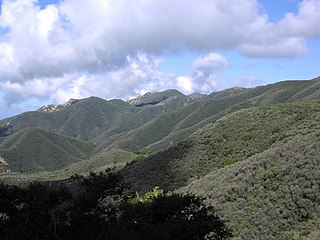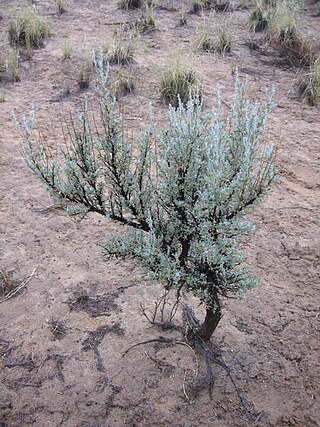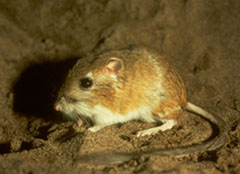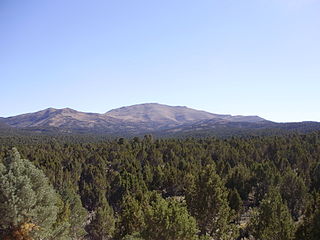Related Research Articles

Chaparral is a shrubland plant community found primarily in California, in southern Oregon and in the northern portion of the Baja California Peninsula in Mexico. It is shaped by a Mediterranean climate and infrequent, high-intensity crown fires.

The Great Basin Desert is part of the Great Basin between the Sierra Nevada and the Wasatch Range. The desert is a geographical region that largely overlaps the Great Basin shrub steppe defined by the World Wildlife Fund, and the Central Basin and Range ecoregion defined by the U.S. Environmental Protection Agency and United States Geological Survey. It is a temperate desert with hot, dry summers and snowy winters. The desert spans large portions of Nevada and Utah, and extends into eastern California. The desert is one of the four biologically defined deserts in North America, in addition to the Mojave, Sonoran, and Chihuahuan Deserts.

Artemisia tridentata, commonly called big sagebrush, Great Basin sagebrush or simply sagebrush, is an aromatic shrub from the family Asteraceae.

The ecology of California can be understood by dividing the state into a number of ecoregions, which contain distinct ecological communities of plants and animals in a contiguous region. The ecoregions of California can be grouped into four major groups: desert ecoregions, Mediterranean ecoregions, forested mountains, and coastal forests.

The ecology of the Sierra Nevada, located in the U.S. states of California and Nevada, is diverse and complex. The combination of climate, topography, moisture, and soils influences the distribution of ecological communities across an elevation gradient from 500 to 14,500 feet. Biotic zones range from scrub and chaparral communities at lower elevations, to subalpine forests and alpine meadows at the higher elevations. Particular ecoregions that follow elevation contours are often described as a series of belts that follow the length of the Sierra Nevada. There are many hiking trails, paved and unpaved roads, and vast public lands in the Sierra Nevada for exploring the many different biomes and ecosystems.

Purshia tridentata, with the common name bitterbrush, is a shrub in the genus Purshia of the family Rosaceae. It is native to mountainous areas of western North America.

Shrub-steppe is a type of low-rainfall natural grassland. While arid, shrub-steppes have sufficient moisture to support a cover of perennial grasses or shrubs, a feature which distinguishes them from deserts.

Ord's kangaroo rat is a kangaroo rat native to western North America, specifically the Great Plains and the Great Basin, with its range extending from extreme southern Canada to central Mexico.

Ranunculus glaberrimus, the sagebrush buttercup, is a species of flowering plant in the buttercup family, Ranunculaceae. It is native to interior western North America, in western Canada, the western United States, and the northwestern Great Plains.

Ephedra viridis, known by the common names green Mormon tea, Brigham tea, green ephedra, and Indian tea, is a species of Ephedra. It is indigenous to the Western United States, where it is a member of varied scrub, woodland, desert, and open habitats. It grows at 900–2,300 metres (3,000–7,500 ft) elevations.

Lycium andersonii is a species of flowering plant in the nightshade family, Solanaceae. Its common names include water-jacket, redberry desert-thorn, Anderson thornbush, Anderson's desert thorn, Anderson boxthorn, Anderson lycium, Anderson wolfberry, and squawberry.
The Piper Mountain Wilderness is a federally designated wilderness area located in the White Mountains 20 miles (32 km) northeast of Big Pine, California in Inyo County, California.

Pinyon–juniper woodland, also spelled piñon–juniper woodland, is a biome found mid-elevations in arid regions of the Western United States, characterized by being an open forest dominated by low, bushy, evergreen junipers, pinyon pines, and their associates. At lower elevations, junipers often predominate and trees are spaced widely, bordering on and mingling with grassland or shrubland, but as elevation increases, pinyon pines become common and trees grow closer, forming denser canopies. Historically, pinyon-juniper woodland provided a vital source of fuel and food for indigenous peoples of the American Southwest. The nuts continue to be a traditional indigenous food, and because nut-collecting was also adopted by the Spanish in the 1500s, the nuts are also traditionally harvested by some Hispanic communities.

The Great Basin montane forests is an ecoregion of the Temperate coniferous forests biome, as designated by the World Wildlife Fund (WWF).

Purshia glandulosa is a species of flowering plant in the rose family known by the common names antelope bitterbrush, desert bitterbrush, Mojave antelope brush, and cliff-rose.
Creosote bush scrub is a North American desert vegetation type of sparsely but evenly spaced desert plants dominated by creosote bush and its associates. Its visual characterization is of widely spaced shrubs that are somewhat evenly distributed over flat or relatively flat desert areas that receive between 2 and 8 inches of rain each year. It covers the majority of the flat desert floor and relatively flat alluvial fans in the Mojave Desert, Chihuahuan Desert, and Sonoran Desert. The dominant plants that typify this vegetation type are creosote bush and its associates, white bur-sage, brittlebush, cheese-bush, Mojave yucca, silver cholla cactus, and beavertail cactus. Creosote bush has a wider range than its associates, so codominant shrubs, which are associated with more narrow ranges, will vary from region to region.
Blackbush scrub, or blackbrush scrub, is a vegetation type of the Western United States deserts characterized by low growing, dark gray blackbush as the dominant species. Blackbush often occurs in pure stands, giving a uniform dark gray appearance to the landscape.
The flora of the Colorado Plateau and Canyonlands region is generally characterized by plant adaptations to the arid conditions of the region, and a wide variation of plant communities from wide variations in elevation and soil types. The elevation variation results in temperature variation. Differing soil types are largely due to erosion of different sedimentary layers in the canyons, from the layers at lowest point of canyons of the Colorado River network, to the top layers of the plateau. Exceptions to flora adapted to aridity occur in lowland riparian areas, at springs, and in hanging gardens.
The Ord Mountains are a small range six miles south of the Apple Valley post office, and five miles southeast of the Hesperia post office. They are about 6.4 miles long, about three miles wide at the south end, and less than 1.5 miles wide in the north.